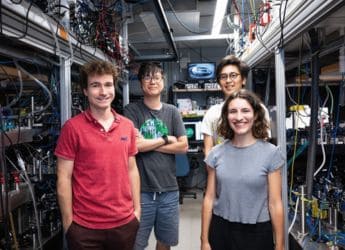- Home
- Science
- Science News
- Researchers Build Record 6,000 Qubit Quantum Machine That Works at Room Temperature
Researchers Build Record 6,000-Qubit Quantum Machine That Works at Room Temperature
Scientists have constructed a 6,100-qubit quantum array working at room temperature, setting new benchmarks in coherence and scale.

Photo Credit: Caltech/Lance Hayashida
Caltech team builds 6,100-qubit neutral-atom array working at room temp with record-high coherence times
Scientists have built a 6,000-qubit quantum system as a result of a remarkable experiment. This result helps to redefine the future of computing, although it functions at room temperature. The achievement denotes a significant step, as this facilitates the development of large-scale quantum computers that can address problems beyond classical machines. Quantum systems need to be kept extremely cold commonly; however, this one uses neutral atoms, and it is managed by lasers, still works with accuracy. Experts noted that this progress brings us closer to having practical quantum computers, allowing us to work in normal conditions."
Caltech Scientists Build 6,000-Qubit Quantum System That Works at Room Temperature, Redefining the Future of Computing
According to a Live Science report, researchers from the California Institute of Technology created the system using optical tweezers to trap over 6,100 atoms arranged in a grid. The atoms were managed by using finely tuned laser beams. It is also allowing scientists to have a notable coherence time of 12.6 seconds and an operation fidelity of 99.98%. These outcomes point to one of the most stable and large-scale quantum systems ever built. All are functioning at normal laboratory temperatures.
The team also demonstrated that atoms could be moved across tiny distances without losing their quantum states—a key requirement for building fault-tolerant and scalable machines. This ability to “shuttle” atoms opens the door to more complex operations, such as implementing quantum error correction and linking multiple processors together.
To existing superconducting and ion-trap technologies, this development makes neutral-atom platforms strong competitors. This relies on expensive cooling systems, and although challenges remain, such as managing entanglement across thousands of qubits. This experiment proves that large, coherent quantum systems are achievable outside extreme environments.
Researchers believe this milestone will inspire a new generation of hybrid quantum systems designed to balance stability, scalability, and simplicity. As the technology advances, the dream of practical quantum computing may be closer than ever before.
For the latest tech news and reviews, follow Gadgets 360 on X, Facebook, WhatsApp, Threads and Google News. For the latest videos on gadgets and tech, subscribe to our YouTube channel. If you want to know everything about top influencers, follow our in-house Who'sThat360 on Instagram and YouTube.
Related Stories
- Samsung Galaxy Unpacked 2025
- ChatGPT
- Redmi Note 14 Pro+
- iPhone 16
- Apple Vision Pro
- Oneplus 12
- OnePlus Nord CE 3 Lite 5G
- iPhone 13
- Xiaomi 14 Pro
- Oppo Find N3
- Tecno Spark Go (2023)
- Realme V30
- Best Phones Under 25000
- Samsung Galaxy S24 Series
- Cryptocurrency
- iQoo 12
- Samsung Galaxy S24 Ultra
- Giottus
- Samsung Galaxy Z Flip 5
- Apple 'Scary Fast'
- Housefull 5
- GoPro Hero 12 Black Review
- Invincible Season 2
- JioGlass
- HD Ready TV
- Laptop Under 50000
- Smartwatch Under 10000
- Latest Mobile Phones
- Compare Phones
- Samsung M17 5G
- HMD Touch 4G
- Vivo V60e
- Lava Bold N1 Lite
- Samsung Galaxy F07
- Realme 15x 5G
- OPPO A6 5G
- Samsung Galaxy M07
- Asus Vivobook S16 (S3607QA)
- Gigabyte AORUS Master 16
- Samsung Galaxy Tab A11+
- Xiaomi Pad 8
- Xiaomi Smart Band 10 Glimmer Edition
- Xiaomi Watch S4 41mm
- Xiaomi Xiaomi TV S Pro Mini LED 55 2026
- Xiaomi TV S Pro Mini LED 65 2026
- Asus ROG Ally
- Nintendo Switch Lite
- Haier 1.6 Ton 5 Star Inverter Split AC (HSU19G-MZAID5BN-INV)
- Haier 1.6 Ton 5 Star Inverter Split AC (HSU19G-MZAIM5BN-INV)
















